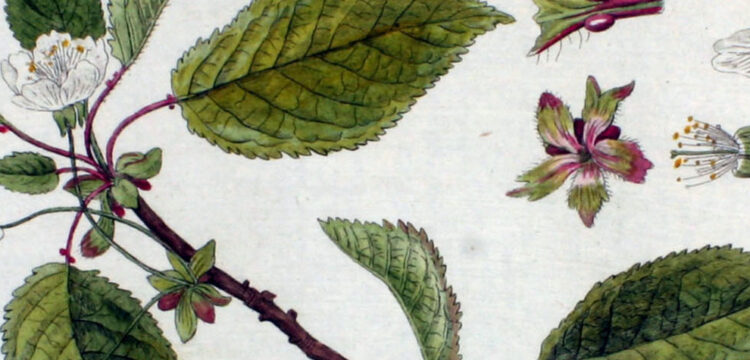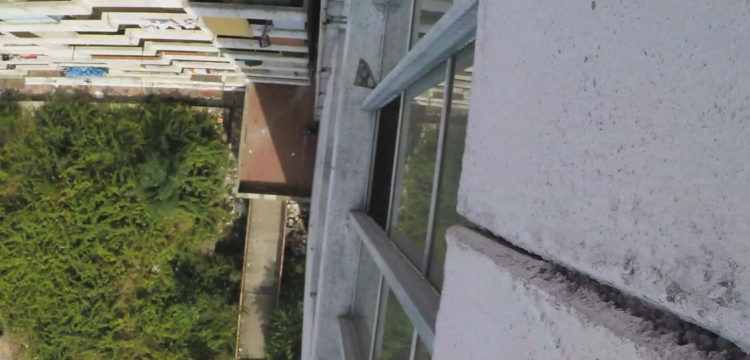A Story of Displacement
When Lydia Ourahmane places the Kunsthalle Basel in limbo
For her first exhibition at the Kunsthalle Basel, Lydia Ourahmane (Saïda, DZ – 1992) presents the newly commissioned work Barzakh, an “exhibition-as-limbo, that waits for you to sit down and stretch your legs, to let down your guard, to treat this place like home.” Spaces of transaction are often the conceptual starting point for the artist’s work, which explores ways in which histories of displacement and colonial oppression are inscribed upon bodies.
It was months since I had last seen an exhibition. It was upon leaving my home that I headed to the Kunsthalle Basel to see Barzakh, the first solo presentation in Switzerland of Algerian artist Lydia Ourahmane. Often compared to the Christian equivalent of “limbo”, “barzakh” is known to be a place of transition, a midway space, an in-between state where the soul rests before continuing its journey to the afterlife. Barzakh is also known to be a strip of land between two seas or territories. A place of refuge.
The themes of migration, displacement, and the allegories of presence and absence lie at the heart of Lydia Ourahmane’s work. At Kunsthalle Basel, the artist presents an installation in which memory pulses and the objects bear witness of a colonial past and its legacy. The objects have made their way to Basel directly from Ourahmane’s apartment in Algiers, on 21 Boulevard Mustapha Benboulaid. It is the flat where she has been living for the last two years, and the only one that she could get as a single woman (after 34 visits!). But first and foremost, it is the flat of Ourahmane’s recently deceased landlady, whose furniture, books, sheets, towels, crockery, and other personal belongings were left intact. Ourahmane lives with and through the woman’s objects, history and ghosts that inhabit the place. The domestic configuration of the installation forms a space that appears familiar and at the same time unknown. Are these objects foreign or are we, visitors, the foreigners of this home?
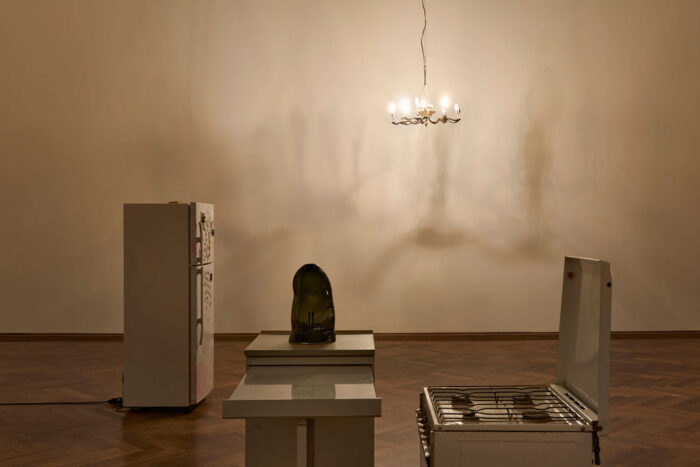
The furniture is arranged in the main room of the Kunsthalle Basel in an exaggeratedly spaced manner to intensify the sense of emptiness. It lets visitors wander in the intimate space of not one but two people. Intergenerational, the lives of these two women resemble and overlap. Still young, Ourahmane left Algeria with her parents for England, where she studied and graduated in visual arts at Goldsmiths College of Art in London. Similarly, the owner lived in Europe, married to a German man before moving back to her roots in Algiers a few years later. Divorced, she brought with her traditional German furniture. An impressionist painting—perhaps inspired by a Swiss mountain landscape—hangs lonely in the back room of the Kunsthalle Basel. In the central room, there is a number of domestic items: a cooker, a desk, a bed, a couch to sit on, Lydia’s personal photographs on the fridge, a ninja turtle at the foot of the couch (probably moved around by visitors), antique chandeliers, keys, letters, postcards, a disc-player, a tea set, bed sheets, a quantity of small trinkets and books of all sorts (between the Bible, novels in German, French and Arabic or art books from Merce Cunningham to Sophia Al-Maria laying on the coffee table). Everything interlaces and intertwines, tempting visitors to look, touch, and wonder what belongs to whom. Embarking on an unsettling and voyeuristic journey, dust on the radio immediately brings me back to the reality of these objects: they have travelled here to Basel, almost 1,500km away from Algiers crossing sea and countries. They are literal and “real” in that they are testimonies of a past and present life. Extracted from their original context and in limbo until their return, they carry a psychological charge that goes beyond the idea of the ready-made and the object of art. It makes me wonder what constitutes the most troubling part of the installation, is it the living presence of memories or the absence of its living bodies?
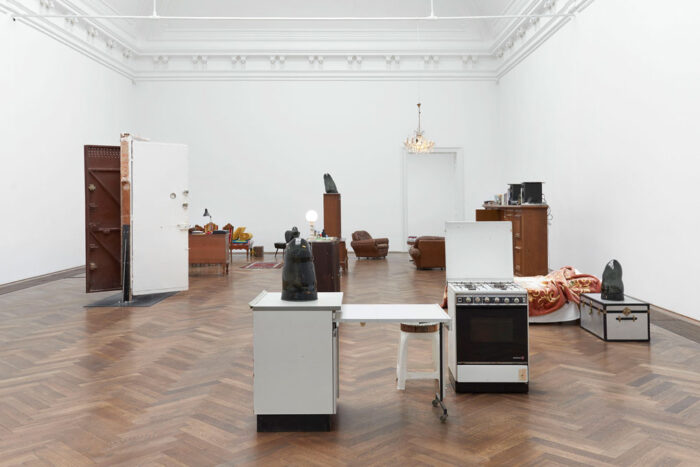
Who am I to enter someone’s home and stroll around this supposedly intimate space. A central piece in Lydia Ourahmane’s installation is the front door of the flat, erected as a massive sculpture in the middle of the room. The wooden door decorated in the French architectural style is reinforced by another steel door with 9 locks. This door (or doors) echoes Algeria’s colonial history and the fear that inhabited Algerians for decades of war and long-lasting political turbulence. The fear of having one’s home violated and being attacked is anchored in people’s minds and inherited patterns. But what about the current flat’s door in Algiers? If the gate was fortified multiple times to ensure security and preserve the privacy of its inhabitants, its removal from Algiers to Basel results in doing the opposite, leaving the most private sphere no longer protected. For Ourahmane, the gate’s displacement plays another role: after many sufferings and embodied fears, it is finally freed from its own history—a subtle allusion to migration, to people fleeing their country and seeking refuge to where there might be a safer environment.
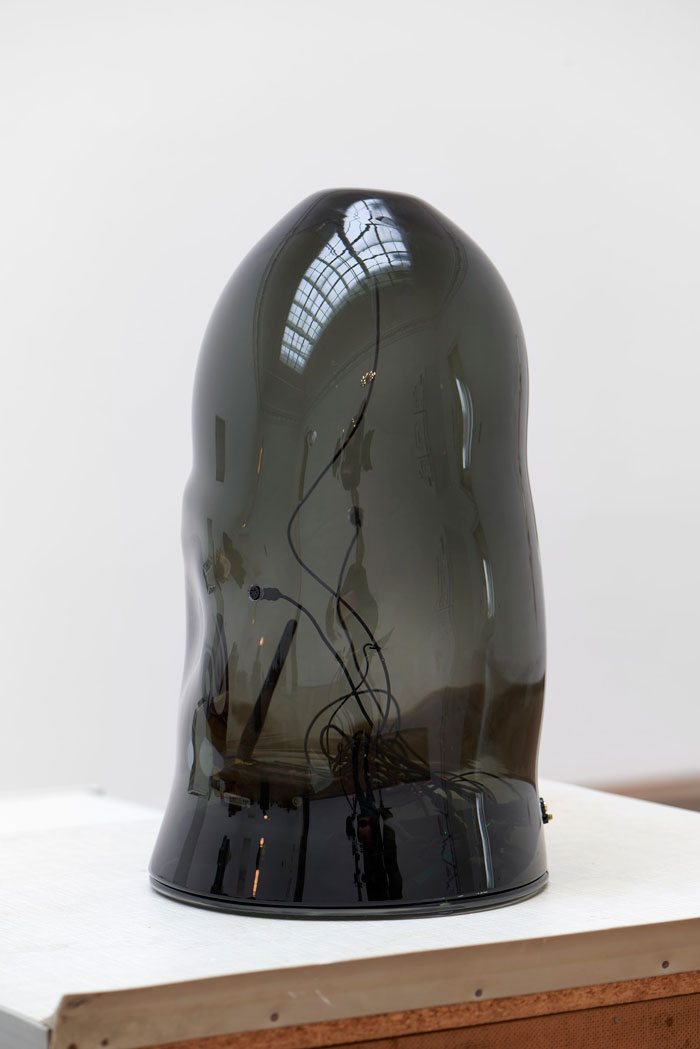
view on, +41 76 655 48 55, 2021. Photo Philipp Hänger / Kunsthalle Basel.
Speaking of safety, the artist does not leave the visitors to walk free around the flat. We are being spied on within the Kunsthalle Basel. Conical-shaped glasses, that look like elongated skulls, lay on a few dispersed tables. Inside them, a number of mini sensors intercept sounds emitted by the visitors. These bugging devices are associated with Swiss phone numbers and anyone anywhere in the world can call and listen to what is happening in the room (try by calling +41 77 207 89 09). This domestic infiltration is supplemented by a laser system that traverses the whole room and circulates outside the institution. It is connected to a sound system that generates vibrations, a white noise, a persistent and almost imperceptible buzzing, giving a dim ambiance to the space. Depending on the weather, or if an element interferes with the laser (e.g. a bird outside or a visitor inside), the sound is interrupted or modified. Reminiscent of warfare weapons, both the bugging device and the laser are inserted by the artist to challenge our sense of security. A critical stance to the obsessive surveillance systems injected in contemporary societies. Visitors’ bodies become targets, invited to circulate in a place of control, triggering the notion of a safe nest. With devices so well integrated in domestic interiors, such as Amazon’s Alexia or smartphones, even our homes are scrutinised. The “eye” is present in all forms. Visitors are violating intimacy, getting close to personal belongings and souvenirs, but they are spied on in return, because nothing is for free. I’m a “voyeuse” who is being watched. Does limbo also mean to be confined?
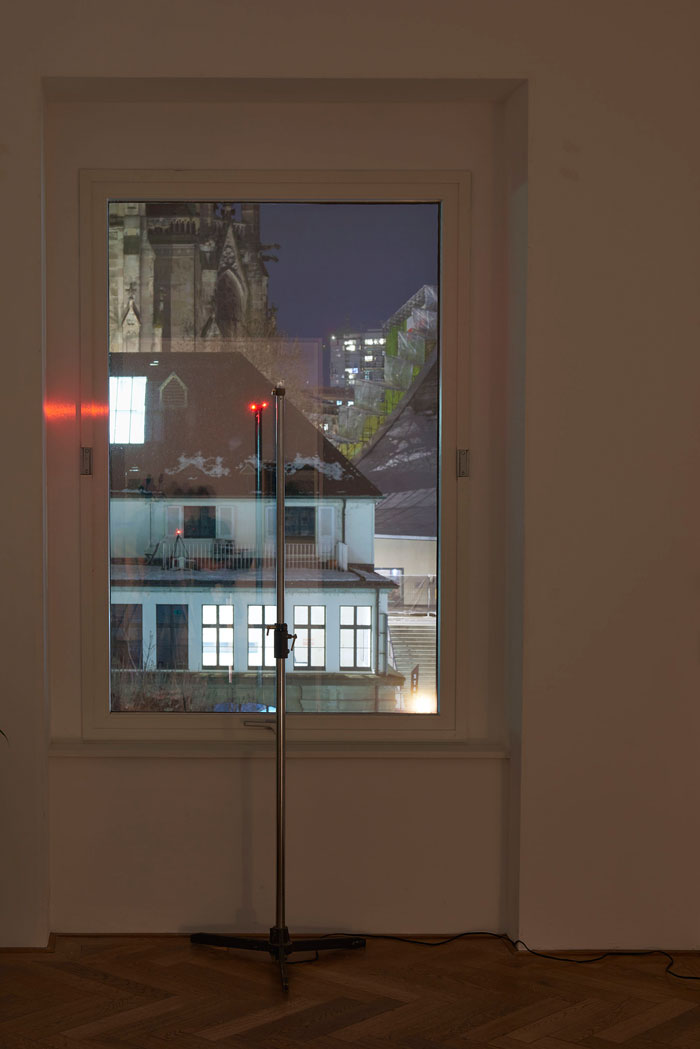
The emotional, social and political dimension of this exhibition is experienced through objects that are familiar but not our own. There is a discrepancy between the impersonal technologies that monitor bodies in time and space and the furniture that lodges history in their guts. Ourahmane investigates these systems of dissemination and the entanglement between past and present, visible and invisible. It is said that the bugging device’s shape refers to an ancient civilisation tradition, one that attempts to remodel skulls upwards to allow the spirit to be closer to heaven. This idea of getting closer to the beyond brings me back to the term barzakh. A place of elevation where the soul—or the “third eye” retrieved from oriental origins—sees beyond the ordinary. Halfway between the divine and the commonplace, barzakh is a place for the sensible, the imaginary, the unconscious to be accessed through meditation and dreams. As stated in the introduction of Dreams that Matter by Amira Mittermaier (2011), barzakh “ruptures binary outlooks and invites us to think beyond the present and the visible. It invites us to dwell on the in-between” (p.4). While the exhibition thematises in a charged and poetic way this idea of transition, we remain in limbo, unsure of what will happen when we wake up from this moment of suspension. We ponder on the fate or destination of the flat once it leaves its barzakhian space and how does this process invite us to see beyond the ordinary…




